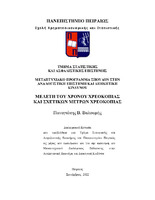Μελέτη του χρόνου χρεοκοπίας και σχετικών μέτρων χρεοκοπίας
Study of the distribution of the time to ruin and related ruin measures

Master Thesis
Συγγραφέας
Βαλσαμής, Παναγιώτης
Ημερομηνία
2022-09Επιβλέπων
Χατζηκωνσταντινίδης, ΕυστάθιοςΠροβολή/
Λέξεις κλειδιά
Χρόνος χρεοκοπίας ; Σχετικά μέτρα χρεοκοπίας ; Συνάρτηση Gerber-Shiu ; Μοντέλο κινδύνου Sparre AndersenΠερίληψη
Μετά την εισαγωγή της συνάρτησης προεξοφλημένης ποινής από τους Gerber και Shiu (1998),
έχει σημειωθεί σημαντική πρόοδος στην ανάλυση διαφόρων ποσοτήτων που σχετίζονται με την
καταστροφή στη θεωρία του κινδύνου. Όπως γνωρίζουμε, η συνάρτηση προεξοφλημένη ποινής
όχι μόνο παρέχει μια συστηματική πλατφόρμα για την από κοινού ανάλυση διαφόρων
ποσοτήτων ενδιαφέροντος, αλλά προσφέρει επίσης την ευκολία για την εξαγωγή βασικών
πληροφοριών από την οπτική γωνία της διαχείρισης κινδύνου. Για παράδειγμα, εξαλείφοντας τη
συνάρτηση ποινής, η συνάρτηση Gerber-Shiu μετατρέπεται σε μετασχηματισμό Laplace Stieltjes του χρόνου χρεοκοπίας, η αντιστροφή του οποίου οδηγεί σε ανάπτυγμα σειράς για τη
σχετική πυκνότητα του χρόνου χρεοκοπίας (βλέπε, π.χ., Dickson and Willmot (2005)). Στην
παρούσα εργασία, προτείνουμε να αναλύσουμε το μακροχρόνιο πρόβλημα της χρεοκοπίας σε
πεπερασμένο χρόνο ενσωματώνοντας τον αριθμό των απαιτήσεων μέχρι τη χρεοκοπία στην
ανάλυση Gerber-Shiu. Όπως θα δούμε στο Κεφάλαιο 2, πολλές ωραίες αναλυτικές ιδιότητες της
αρχικής συνάρτησης Gerber-Shiu διατηρούνται από αυτό το γενικευμένο αναλυτικό εργαλείο.
Για παράδειγμα, η συνάρτηση Gerber-Shiu εξακολουθεί να ικανοποιεί ένα ελαττωματική
ανανεωτική εξίσωση και μπορεί γενικά να εκφραστεί σε όρους κάποιων ριζών της γενικευμένης
εξίσωσης Lundberg στο μοντέλο κινδύνου Sparre Andersen.
Στην παρούσα διατριβή, προτείνουμε όχι μόνο να ενοποιήσουμε τις προηγούμενες
μεθοδολογίες για τη μελέτη της πυκνότητας του χρόνου μέχρι την καταστροφή μέσω της χρήσης
του θεωρήματος επέκτασης του Lagrange, αλλά και να παράσχουμε πληροφορίες για τη φύση
του αναπτύγματος σειράς προσδιορίζοντας την πιθανολογική συμβολή κάθε όρου στην
επέκταση μέσω της ανάλυσης που περιλαμβάνει την κατανομή του αριθμού των απαιτήσεων
εώς τη χρεοκοπία. Στο Κεφάλαιο 3, μελετάμε την από κοινού γενικευμένη πυκνότητα του
χρόνου χρεοκοπίας και του αριθμού των απαιτήσεων μέχρι τη χρεοκοπία στο κλασικό σύνθετο
Poisson μοντέλο κινδύνου. Χρησιμοποιούμε επίσης μια εναλλακτική προσέγγιση για να
λάβουμε την πυκνότητα του χρόνου χρεοκοπίας με βάση την τεχνική αντιστροφής Lagrange που
εισήγαγαν οι Dickson και Willmot (2005). Στο Κεφάλαιο 4, βασιζόμενοι στο θεώρημα
επέκτασης Lagrange για αναλυτική αντιστροφή, εξετάζουμε την από κοινού πυκνότητα του
χρόνου μέχρι τη χρεοκοπία, του πλεονάσματος αμέσως πριν από τη χρεοκοπία και του αριθμού
των απαιτήσεων μέχρι τη χρεοκοπία στο μοντέλο κινδύνου Sparre Andersen με εκθετικά μεγέθη
απαιτήσεων και αυθαίρετους ενδιάμεσους χρόνους.
Εξ όσων γνωρίζουμε, τα υπάρχοντα αποτελέσματα σχετικά με το πρόβλημα της χρεοκοπίας σε
πεπερασμένο χρόνο στο μοντέλο κινδύνου Sparre Andersen περιλαμβάνουν συνήθως μια
εκθετική υπόθεση είτε για τους ενδιάμεσους χρόνους είτε για τα μεγέθη των απαιτήσεων (βλέπε,
π.χ., Borovkov and Dickson (2008)). Μεταξύ των λίγων εξαιρέσεων, αναφέρουμε τους Dickson
και Li (2010, 2012), οι οποίοι ανέλυσαν την πυκνότητα του χρόνου χρεοκοπίας για Erlang-𝑛
ενδιάμεσους χρόνους. Στο Κεφάλαιο 5, προτείνουμε μια σημαντική ανακάλυψη
χρησιμοποιώντας την πολυμεταβλητή εκδοχή του θεωρήματος επέκτασης Lagrange για να
λάβουμε ένα ανάπτυγμα σειράς για την πυκνότητα του χρόνου χρεοκοπίας υπό μια πιο γενική
υπόθεση κατανομής, δηλαδή όταν οι ενδιάμεσοι χρόνοι κατανέμονται ως συνδυασμός 𝑛
εκθετικών. Αξίζει να τονιστεί ότι η τεχνική αυτή μπορεί να εφαρμοστεί και σε άλλους τομείς
των εφαρμοσμένων πιθανοτήτων. Για παράδειγμα, η προτεινόμενη μεθοδολογία μπορεί να
χρησιμοποιηθεί για να ληφθεί η κατανομή ορισμένων χρόνων πρώτης διέλευσης για
συγκεκριμένες στοχαστικές διαδικασίες. Ενδεικτικά, θα εξεταστεί η διάρκεια μιας περιόδου
αιχμής σε ένα μοντέλο κινδύνου ουράς αναμονής.
Τέλος, στο κεφάλαιο 8 διατυπώνονται ορισμένες συμπερασματικές παρατηρήσεις και γίνεται
συζήτηση για μελλοντική έρευνα.


